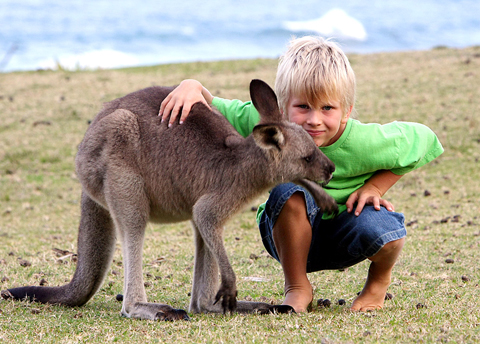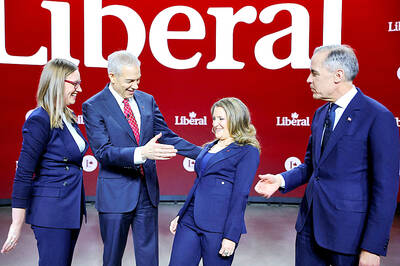Saving the planet by eating kangaroos and wild camels may seem like pie in the sky, but the offbeat menu comes with a scientific stamp of approval in Australia.
The aim in both cases is to reduce damage to the environment, but the reasoning behind the push to put the animals on the menu is sharply different.
In the case of kangaroos, environmentalists say the national animal should become a dietary staple in place of cattle and sheep as part of the fight against global warming.

PHOTO: AFP
The farm animals make a major contribution to Australia’s greenhouse gas emissions simply by belching and farting, while kangaroos emit negligible amounts of dangerous methane gas.
In other words, there should be more kangaroos and fewer farm animals.
“For most of Australia’s human history — around 60,000 years — kangaroo was the main source of meat,” the government’s top climate change adviser professor Ross Garnaut, said in a major report on global warming recently.
“It could again become important.”
In the case of camels, scientists say eating the imported animals would be one way of reducing the million-strong feral herd — one of the largest on earth — running amok in the fragile ecosystems of the outback.
“Eat a camel today, I’ve done it,” says professor Murray McGregor, co-author of a three-year study on the humpbacked pests presented to the government last month.
In each case, the scientists admit they face a struggle to change Australia’s eating habits, but believe strongly in the need to somehow cut the numbers of sheep, cattle and camels.
Garnaut’s study concluded that by 2020, beef cattle and sheep numbers could be reduced by 7 million and 36 million respectively, allowing for an increase in kangaroo numbers to 240 million by 2020, from 34 million now.
He acknowledged, however, that there were some problems in this plan, including livestock and farm management issues, consumer resistance and the gradual nature of change in food tastes.
The idea of farming kangaroos — which appear on the Australian coat of arms — for human consumption is distasteful to some, but many health-conscious Australians already eat kangaroo meat.
“It’s low in fat, it’s got high protein levels, it’s very clean in the sense that basically it’s the ultimate free range animal,” says Peter Ampt of the University of New South Wales’s institute of environmental studies.
A similar argument was put forward last month in an attempt to whet Australian appetites for camel meat.
A three-year study found that Australia’s population of more than a million feral camels is out of control and damaging fragile desert ecosystems, water sources, rare plants and animals.
The Desert Knowledge Cooperative Research Center, which produced the report presented to the federal government, said a good way to bring down the number of camels is to eat them.
“It’s beautiful meat. It’s a bit like beef. It’s as lean as lean, it’s an excellent health food,” McGregor said.
Unlike the native kangaroo, camels were introduced into Australia as pack animals for the vast outback in the late 19th and early 20th centuries, but were released into the wild as rail and road travel became more widespread.
With few natural predators and vast sparsely populated areas in which to roam, the population has soared to around a million and is now doubling about every nine years, the center’s Glenn Edwards said.
While putting camels on the menu could help reduce their numbers, and is one of the proposals in the report, Edwards admits it is unlikely that Australia can eat its way out of the problem.
Hundreds of thousands of camels will have to be removed to bring the numbers down to a point where they cause minimal damage, he said.
“I think [eating them] is an option that may work in some areas but it won’t be the panacea,” he said.
The local market for camel meat would be limited and even given the fact that there is a large demand from some countries overseas it would be difficult to harvest and process the animals.
Switching from cattle and sheep to kangaroos also faces problems, said beef farmer Kelvin Brown.
Transporting kangaroos to the abattoir would also be fraught with difficulties.

When Shanghai-based designer Guo Qingshan posted a vacation photo on Valentine’s Day and captioned it “Puppy Mountain,” it became a sensation in China and even created a tourist destination. Guo had gone on a hike while visiting his hometown of Yichang in central China’s Hubei Province late last month. When reviewing the photographs, he saw something he had not noticed before: A mountain shaped like a dog’s head rested on the ground next to the Yangtze River, its snout perched at the water’s edge. “It was so magical and cute. I was so excited and happy when I discovered it,” Guo said.

Chinese authorities said they began live-fire exercises in the Gulf of Tonkin on Monday, only days after Vietnam announced a new line marking what it considers its territory in the body of water between the nations. The Chinese Maritime Safety Administration said the exercises would be focused on the Beibu Gulf area, closer to the Chinese side of the Gulf of Tonkin, and would run until tomorrow evening. It gave no further details, but the drills follow an announcement last week by Vietnam establishing a baseline used to calculate the width of its territorial waters in the Gulf of Tonkin. State-run Vietnam News

TURNAROUND: The Liberal Party had trailed the Conservatives by a wide margin, but that was before Trump threatened to make Canada the US’ 51st state Canada’s ruling Liberals, who a few weeks ago looked certain to lose an election this year, are mounting a major comeback amid the threat of US tariffs and are tied with their rival Conservatives, according to three new polls. An Ipsos survey released late on Tuesday showed that the left-leaning Liberals have 38 percent public support and the official opposition center-right Conservatives have 36 percent. The Liberals have overturned a 26-point deficit in six weeks, and run advertisements comparing the Conservative leader to Trump. The Conservative strategy had long been to attack unpopular Canadian Prime Minister Justin Trudeau, but last month he

Four decades after they were forced apart, US-raised Adamary Garcia and her birth mother on Saturday fell into each other’s arms at the airport in Santiago, Chile. Without speaking, they embraced tearfully: A rare reunification for one the thousands of Chileans taken from their mothers as babies and given up for adoption abroad. “The worst is over,” Edita Bizama, 64, said as she beheld her daughter for the first time since her birth 41 years ago. Garcia had flown to Santiago with four other women born in Chile and adopted in the US. Reports have estimated there were 20,000 such cases from 1950 to